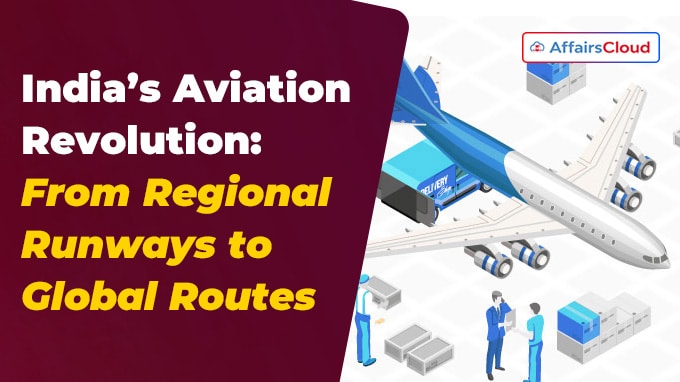 The Ministry of Civil Aviation (MoCA) under the visionary leadership of Prime Minister (PM) Narendra Modi has witnessed transformative growth and innovation in India’s aviation sector. This significant growth was mainly driven by legislative reforms, extensive infrastructure expansion, and inclusive sustainable growth.
The Ministry of Civil Aviation (MoCA) under the visionary leadership of Prime Minister (PM) Narendra Modi has witnessed transformative growth and innovation in India’s aviation sector. This significant growth was mainly driven by legislative reforms, extensive infrastructure expansion, and inclusive sustainable growth.
- This also reflects a robust aviation ecosystem poised to support Government of India (GoI)’s ambitious goal of becoming a developed nation by 2047 i.e. Viksit Bharat @2047.
Key Legislative Reforms by GoI:
i.Protection of Interest in Aircraft Objects Bill, 2025: This legislation was introduced in Parliament by Union Minister Ram Mohan Naidu, MoCA and then, it was passed from both houses of the Parliament in April 2025.
- This bill is in alignment with India’s aircraft leasing and financing framework with global standards set by the Cape Town Convention, 2001.
- It is strategically designed to alleviate aircraft leasing costs for Indian carriers, which were earlier 8% to 10% higher compared to other countries.
ii.Bharatiya Vayuyan Adhiniyam 2024: This Act was passed by both houses of the Parliament in 2024 and later, came into force on January 01, 2025.
- This Act represents a major step in modernizing India’s aviation sector by re-enacting and updating the British colonial-era Aircraft Act, 1934.
- It aims to support domestic manufacturing under the ‘Make in India’ and ‘Atmanirbhar Bharat’ initiatives, aligns regulations with international conventions like: Chicago Convention and the International Civil Aviation Organization (ICAO).
Key Initiatives for Infrastructure Expansion:
i.New Terminals: GoI had laid the foundations of various new terminals at key locations like: Varanasi (Uttar Pradesh, UP), Agra (UP), Darbhanga (Bihar), and Bagdogra(West Bengal, WB).
ii.Greenfield Airports: Since 2014, out 21 ‘in-principle’ approved airports, 12 Greenfield Airports have been operationalised.
- These include Durgapur (West Bengal, WB); Shirdi (Maharashtra); Kannur (Kerala); Pakyong (Sikkim); Kalaburagi (Karnataka); Orvakal (Kurnool, Andhra Pradesh, AP); Sindhudurg (Maharashtra); Kushinagar (Uttar Pradesh, UP); Itanagar (Hollongi, Arunachal Pradesh, AR); Mopa (Goa); Shivamogga (Karnataka) and Rajkot (Hirasar, Gujarat).
- Also, development at Noida (Jewar),UP and Navi Mumbai(Maharashtra) International Airports is progressing rapidly.
- The GoI has set an ambitious target of developing 50 more airports in the next 5 years and these airports are expected to connect 120 new destinations in the next 10 years.
iii.Significant CAPEX in Airport Infrastructure: A substantial Capital Expenditure (CAPEX) of more than Rs 91, 000 crore is planned for airport infrastructure development under the National Infrastructure Pipeline (NIP) during the period of FY20 to FY25, of this total amount, nearly Rs 82,600 crores already spent by November 2024.
Key Progress under RCS-UDAN:
i.RCS-UDAN Connecting India: Since the inception of Regional Connectivity Scheme (RCS)-Ude Desh Ka Aam Nagrik (UDAN) in 2016, total 619 routes have been operationalised and 88 airports have been connected across the country.
ii.Expansion of Regional Connectivity: Total 102 new routes were launched alone in year 2024, including 20 in the North Eastern states.
- The scheme has facilitated affordable air travel for 10.5 million passengers and its aims to expand this to 40 million more in next 10 years through a revamped UDAN initiative to add 120 new destinations.
iii.UDAN Yatri Café: This initiative was launched to facilitate affordable and quality airport food options.
- So far, two UDAN Yatri Cafés have been inaugurated at Netaji Subhas Chandra Bose International (NSCBI) Airport in Kolkata, WB and Chennai Airport in Chennai, Tamil Nadu (TN).
Other Key Initiatives:
i.State-of-the-Art DFDR & CVR Laboratory : In April 2025, Union Minister Kinjarapu Rammohan Naidu, MoCA, inaugurated the state-of-the art facility, Digital Flight Data Recorder and Cockpit Voice Recorder (DFDR & CVR) Laboratory at the Aircraft Accident Investigation Bureau (AAIB) at Udaan Bhavan in New Delhi (Delhi).
- This new facility was established with the support of Bengaluru (Karnataka)-based Hindustan Aeronautics Limited (HAL), with investment of Rs 9 crore.
ii.Expansion of Digi Yatra : So far, 24 airports has received Digi Yatra services, a biometric-based digital tool which provides a seamless, contactless travel experience for passengers.
- Also, more than 80 lakh users have downloaded the application (app) and over 4 crore journeys have been completed using the Digi Yatra facility.
iii.Guidelines Launched for Seaplane Opeartions: In August 2024, GoI introduced the Guidelines for Seaplane Operations in India to enhance regional connectivity further.
- UDAN Round 5.5 includes invitations for seaplane operations from more than 50 water bodies.
Key Development in Promoting Sustainability:
i.Promoting Green Energy Adoption : At present, 80 airports in India are operating on 100% green energy. The GoI aims to switch over 100 airports to Renewable Energy (RE) sources.
- Bengaluru Airport (Karnataka) has achieved the highest Carbon Accreditation Level-5 by Airports Council India (ACI).
ii.Addressing the increasing demand for pilots: The MoCA is actively working on increasing the number of Flight Training Organizations (FTOs) and the annual issuance of commercial pilot licenses, due to the rising need for trained pilots, estimated at 30,000 to 34,000 in the next 10-15 years.
iii.Aviation Career Guidance for Students: In April 2025, Union Civil Aviation Minister launched a ‘Career Guidance Programme in Aviation’ for school students at the Indian Aviation Academy (IAA) in New Delhi, Delhi.
- The initiative aims to inspire and educate students of Class X and Class XII about diverse career options within the aviation sector.
Growth in Passenger Traffic:
i.Exponential growth in domestic passengers: Domestic Air Passenger Traffic more than doubled to 22 crore 81 lakh (in 2024) compared to 10 crore 38 lakh passengers registered in the 65 years preceding 2014.
- Also, domestic air passenger traffic has increased by nearly 6% in the January to November period of 2024 compared to same period in 2023.
ii.Robust Growth in International Traffic: International routes also saw significant growth, with 64.5 million passengers carried between January and November, 2024, reflecting an increase of 11.4%.
iii.India Emerges as a Top Global Aviation Market: The total number air passengers in India annually has exceeded 350 million, thus, consolidating India’s position as the world’s 3rd largest aviation market.
- Over the last 10 years, domestic passenger air traffic has increased 10-12% annually.
Other Key Milestones in Aviation Sector:
i.Maintenance, Repair & Overhaul (MRO): The GoI has introduced a uniform 5% Integrated Goods and Services Tax (IGST) rate for aircraft parts, with the objective of promoting India as a competitive global MRO hub.
ii.Gender Inclusion: At present, India boasts 13-18% of women pilots, which ranks among the highest globally. Also, the Directorate General of Civil Aviation (DGCA) set the target of 25% women representation in all aviation roles by 2025.
iii.International Recognition: In September 2024, India hosted the 2nd Asia-Pacific Ministerial Conference on Civil Aviation (APMC at Bharat Mandapam, New Delhi (Delhi).
iv.Air Cargo Infrastructure: Cargo handling capacity touched 8 million Metric Tonne (MT) in FY24, increasing at the rate of 10% annually with new focus on warehousing for perishables and streamlined customs protocols.
About Ministry of Civil Aviation (MoCA):
Union Minister- Kinjarapu Rammohan Naidu (Constituency- Srikakulam, Andhra Pradesh, AP)
Minister of State (MoS)– Murlidhar Kisan Mohol (Constituency- Pune, Maharashtra)




